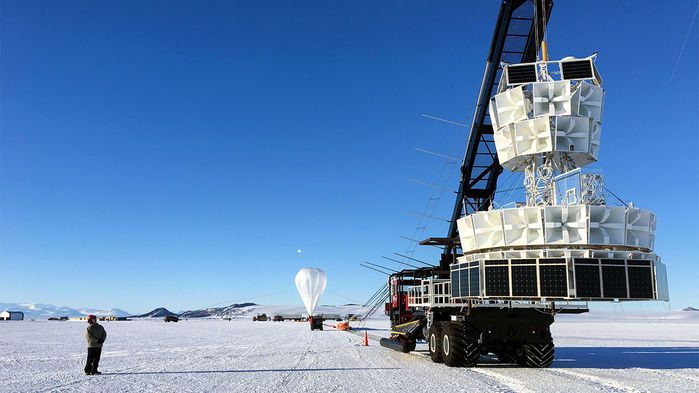
Physicists termed the two detections the "ANITA anomaly," after NASA's Antarctic Impulsive Transient Antenna (ANITA), the airborne detector that picked up the signals.
Now, in a new paper published April 24 in the journal Annals of Glaciology, a joint team of physicists and glaciologists argue that the ANITA anomaly likely isn't evidence for new physics.
Complex, hidden structures in the white expanse might have reflected radio waves in unexpected ways, fooling ANITA's radio receivers into registering the particle as if it were coming from inside Earth.
And all they're detecting from any event is a radio signal.".
But radio signals can hold a lot of information about particles in the extreme high-energy range.
The hope was that in Antarctica, tau neutrinos would sometimes hit Earth at shallow enough angles that they would decay in the ice, producing a tau particle and a characteristic, detectable radio signal from the tau's passage through the ice.
That radio signal has a predictable waveform: a big spike, a big dip, a smaller spike and a smaller dip — a shape mostly determined by Earth's magnetic field.
When that happens, an energized particle — perhaps a proton — hits the atmosphere over Antarctica, bursts into a shower of smaller charged particles, and produces a radio burst that reflects off the ice before hitting ANITA.
But ANITA can tell a tau neutrino from a basic cosmic ray: When the radio waves strike the ice and bounce up at ANITA, their shapes flip.
After years of study, physicists have been left with no easy explanation for the anomalies, said Derek Fox, a neutrino expert at Pennsylvania State University.
A phenomenon known as "coherent transition radiation" might have messed with the radio waves coming from a cosmic-ray shower, two theorists suggested in March 2019.
(It's also possible that some instrumental problem with ANITA might have produced the signal he said, but that's doubtful given how technically adept the ANITA team is.).
Still, Fox said, no one had yet offered a compelling explanation for how air or ice effects could produce the ANITA anomalies.
That was before Shoemaker's team came along, with its unusual combination of particle physicists, radio experts and glaciologists.
The authors of the new study made a straightforward argument: When radio waves passing through air bounce off of a dense object, like the top layer of ice, their waveforms flip in the way ANITA expects.
Snow-covered crevasses, regions of stressed crystal known as "ice fabric layers" and lakes of liquid water buried beneath the frozen surface might all reflect a cosmic ray's radio signal without mirroring it.
Ice fabrics, and another low-density ice feature known as "wind crusts," might explain the anomalies, they said.
No one has looked for firn in the regions when ANITA spotted the anomalies, but it's widespread in Antarctica and can reflect radio waves without mirroring them.
Glaciologists use radio waves to study ice all the time, she said.
"You have all these different layers of densities that could throw the whole signal," Horodyskyj said.
The most baffling implication of Shoemaker's paper, Fox said, is that whatever ice feature may have created the anomaly reflected the signal perfectly.
There is no evidence in the data for any significant perturbations of the signal outside of a normal reflection," Gorham told Live Science.
In this clean mirror model, there would actually have been two radio bursts for each ANITA anomaly.
One, the "primary" reflection, would have been flipped in the way ANITA expects.
Shoemaker said that when he began studying the ANITA anomaly, he was hoping to find evidence for new physics; he didn't set out to debunk the finding.
By rigorously showing how widespread these sorts of features are in the ANITA region, Shoemaker's team made a strong case that some sort of unusual reflection might have caused the ANITA anomaly, Fox said.
So far, Gorham said, the evidence is in favor of nothing strange in the ice.
"The ANITA group has made many studies of Antarctic ice, and has published several papers also in the glaciology literature, going back for a decade or more," he said.
The Shoemaker paper suggested sending a team to the sites of the anomalies and bouncing radio waves off the ice to see what would happen. .
Looking through the glaciology literature, she said, she found little direct data on the makeup of the ice in the region where ANITA spotted the anomalies
A long, physical tube of ice could reveal to the naked eye any unexpected layers that might mess with radio signals, she said